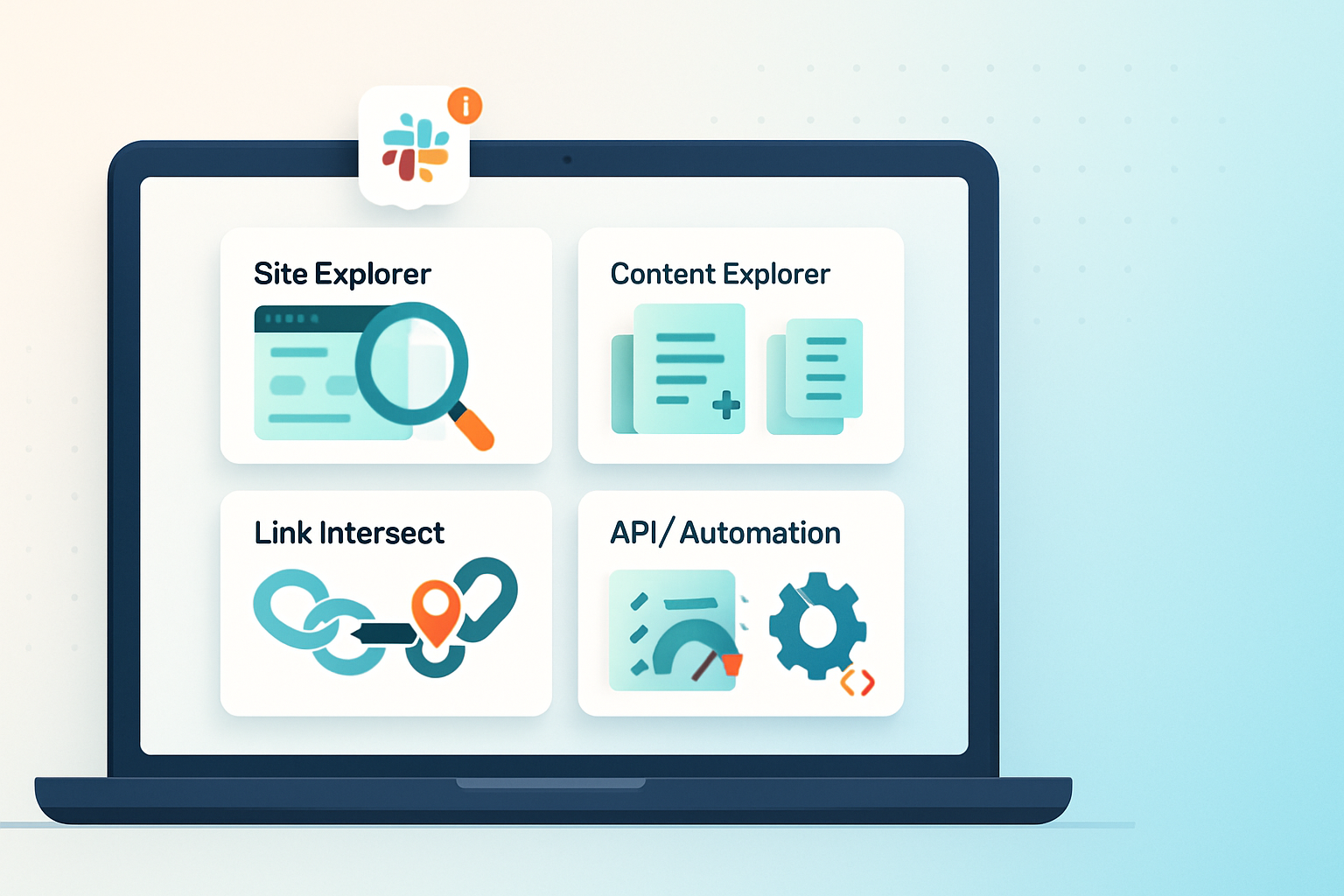· marketing · 6 min read
Unlocking the Hidden Features of Ahrefs: 10 Tips You Might Not Know
Discover 10 lesser-known Ahrefs features that can supercharge your SEO workflow - from advanced Content Explorer queries to custom Site Audit checks, automated alerts, API automation and more, with step-by-step examples and use cases.

Introduction
Ahrefs is one of the most powerful SEO toolkits available - but many teams only scratch the surface of what it can do. Beyond the obvious Site Explorer and Keywords Explorer workflows, Ahrefs hides efficient shortcuts and advanced features that save time, uncover opportunities, and improve results.
Below are 10 lesser-known Ahrefs tips with practical examples and clear use cases you can implement today.
1) Use Link Intersect as an outreach prospecting engine
Why it’s useful: Link Intersect reveals sites linking to multiple competitors but not to you - a goldmine for outreach.
How to do it:
- Go to Site Explorer → More Tools → Link Intersect (or search for “Link Intersect”).
- Enter 2–3 competitor domains in the “Linking domains to” fields and your domain in the “But not linking to” field.
- Sort results by Domain Rating (DR) or Referring Domains and filter by language or URL pattern.
Example use case: Find high-DR listicles linking to competitors’ product pages, then pitch your product with a friendly outreach email offering updated data, images, or an exclusive offer.
Reference: https://help.ahrefs.com/en/articles/3476759-link-intersect
2) Master Content Explorer search operators for smarter content outreach
Why it’s useful: Content Explorer isn’t just for topic research - with the right operators you can find broken listicles, roundups, or resource pages to pitch.
Pro tips:
- Use operators like
intitle:"best",inurl:resources, or"top 10"to target specific formats. - Exclude big domains using
-site:amazon.com -site:youtube.com. - Filter by organic traffic, referring domains, language, and first published date.
Example query: intitle:"best" "marketing tools" -site:amazon.com then filter Content Explorer results to show pages with organic traffic > 500 and referring domains > 5.
Use case: Identify stale listicles that rank well and pitch updated comparisons or exclusive data.
Reference: https://help.ahrefs.com/en/articles/1057375-how-to-use-content-explorer
3) Create custom Site Audit checks and enable JavaScript rendering
Why it’s useful: Many modern sites are single-page apps (SPA) or use JS frameworks; enabling JS rendering in Site Audit helps find issues that a basic crawler misses. Custom checks let you detect schema problems, missing tags, or specific HTML patterns across your site.
How to do it:
- In Site Audit settings, enable JavaScript rendering.
- Use the Custom Checks feature to create XPath/CSS selectors or regex rules that look for things like missing
og:image, absentpriceschema, or incorrect canonical tags.
Example use case: Create a custom check that flags product pages missing structured_data or price schema so your e‑commerce team can prioritize fixes.
Reference: https://help.ahrefs.com/en/articles/2630922-site-audit
4) Automate alerts and route them into Slack/Teams
Why it’s useful: Detect lost backlinks, new mentions, or keyword movements the moment they happen and push them to your team for quick action.
How to do it:
- Set Alerts (New/Lost Backlinks, Mentions, or Keywords) for the domains you care about.
- Use email forwarding or a simple email-to-Slack integration (or webhooks via automation services like Zapier) to route alerts into a channel.
Example workflow: When a high-value backlink is lost, an alert triggers a Slack notification with the URL and anchor - your outreach owner can contact the site immediately to reclaim the link.
Reference: https://help.ahrefs.com/en/articles/2682820-alerts
5) Run Batch Analysis for rapid competitor benchmarking
Why it’s useful: Instead of entering domains one-by-one, Batch Analysis processes up to thousands of domains/URLs quickly and exports core metrics for side-by-side comparison.
How to do it:
- Go to Tools → Batch Analysis.
- Paste a list of competitor domains or product URLs.
- Export metrics (DR, organic traffic, backlinks) as CSV.
- Use spreadsheet functions (VLOOKUP, formulas, or pivot tables) to score and prioritize.
Example use case: Score potential link partners by combining organic traffic and referring domains to create a weighted outreach priority list.
Reference: https://help.ahrefs.com/en/articles/561620-batch-analysis
6) Find “parent topic” and low-competition subtopics with Keywords Explorer
Why it’s useful: Keywords Explorer’s Parent Topic and SERP Features tabs help you find the broader topic to target for maximum topical authority, plus related long-tail opportunities with fewer clicks-to-conversion.
How to do it:
- Enter a seed keyword and check the Parent Topic suggestion - often it’s better to target that if you want to rank for many related terms.
- Use the Also ranks for and SERP overview to spot keywords that the top-ranking pages also rank for (keyword clustering).
Example: If your seed keyword is “email marketing tools” the Parent Topic might be “email marketing” - targeting the parent with a comprehensive guide can capture dozens of related keywords.
Reference: https://ahrefs.com/blog/keywords-explorer/
7) Use the Pages → Best by links + Outgoing links to uncover link equity paths
Why it’s useful: The “Best by links” report shows pages getting the most backlinks and thus the most link equity. Inspecting outgoing/internal links from those pages helps you find natural funnel points for outreach or internal link opportunities.
How to do it:
- In Site Explorer, go to Top Pages → Best by links.
- Click a high-value page and inspect its outgoing links and internal links (Inlinks).
- See which content currently benefits and where an additional link could pass equity to a conversion page.
Use case: Ask the owner of a high-linking article to add a relevant link to your target guide - often easier than earning a brand new backlink.
Reference: https://help.ahrefs.com/en/articles/3476763-site-explorer-overview
8) Treat Inlinks as your internal linking strategy audit tool
Why it’s useful: The Inlinks report (not to be confused with backlinks) shows internal link structure, anchors used, and whether pages are orphaned.
How to use it:
- Run an Inlinks report to find pages with few internal links (low internal PageRank).
- Prioritize internal linking to product/category pages with relevant anchor text.
Example: Find a high-converting product page that has many external backlinks but few internal links - add contextual links from topical articles to boost rankings and conversions.
Reference: https://help.ahrefs.com/en/articles/5084277-inlinks-overview
9) Extract competitor content ideas using Content Gap + SERP history
Why it’s useful: Content Gap shows keywords your competitors rank for but you don’t. Combined with SERP history and the SERP features tabs, you can see which features (e.g., featured snippets, People Also Ask) to target.
How to do it:
- In Site Explorer use Content Gap (or Keywords Gap) and enter 3–5 competitors.
- Filter results by position (e.g., ranks 1–10) and search volume.
- Open SERP Overview for candidate keywords to inspect featured snippets or video results.
Use case: Find medium-volume keywords where competitors hold featured snippets - create a concisely structured answer block with schema to win that SERP feature.
Reference: https://help.ahrefs.com/en/articles/561612-how-to-use-the-content-gap-tool
10) Automate reporting and enrich data with the Ahrefs API
Why it’s useful: The Ahrefs API lets you pull Ahrefs metrics into BI tools, Google Sheets, or internal dashboards for custom reports and automation.
Basic example (pseudocode):
# Pseudocode curl call
curl "https://apiv2.ahrefs.com?token=YOUR_TOKEN&from=site_explorer&target=example.com&mode=domain&output=json"What to automate:
- Daily/weekly checks for lost backlinks to feed your outreach queue.
- Monthly snapshots of organic traffic estimates for hundreds of domains.
- Automated keyword lists exported to your CMS for content briefs.
Reference and docs: https://ahrefs.com/api
Conclusion - How to prioritize these tips
- Quick wins - Link Intersect (tip 1), Content Explorer queries (tip 2), and Alerts (tip 4).
- Technical & structural improvements - Site Audit custom checks (tip 3) and Inlinks (tip 8).
- Scale and automation - Batch Analysis (tip 5) and the API (tip 10).
Start by picking 2–3 tips that align with your current pain points. Implement them, measure the impact for 30–60 days, then expand. Ahrefs’ depth rewards experimentation: small systematic changes (one outreach list, one custom audit rule, one internal linking campaign) compound quickly.
Further reading
- Ahrefs Blog (strategy and case studies): https://ahrefs.com/blog/
- Ahrefs Help Center (tool-specific docs): https://help.ahrefs.com/



